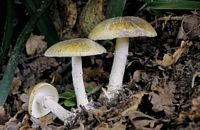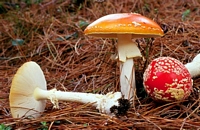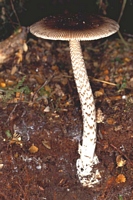Amanita phalloides
|
 | Death cap. An exotic species found under oaks in Auckland and Hamilton. The cap is often more or less smooth, or with few scales. This is an extremely poisonous mushroom, and there have been several near-deaths in New Zealand after it apparently had been |
|

|

|
Amanita muscaria
|
 | Fly agaric. An exotic species common throughout the country under a wide range of introduced ectomycorrhizal trees, but is particularly common under pines and silver birch. This is one of the few introduced fungi which has become naturalised in native fo |
|

|

|
Amanita pekeoides
|
 | A common native species with a large, loose volva (the species was named after the Maori word peke, meaning sack or bag) and no ring on the stalk. The edge of the cap is characteristically strongly striate. White forms of this species are found rarely. |
|

|

|